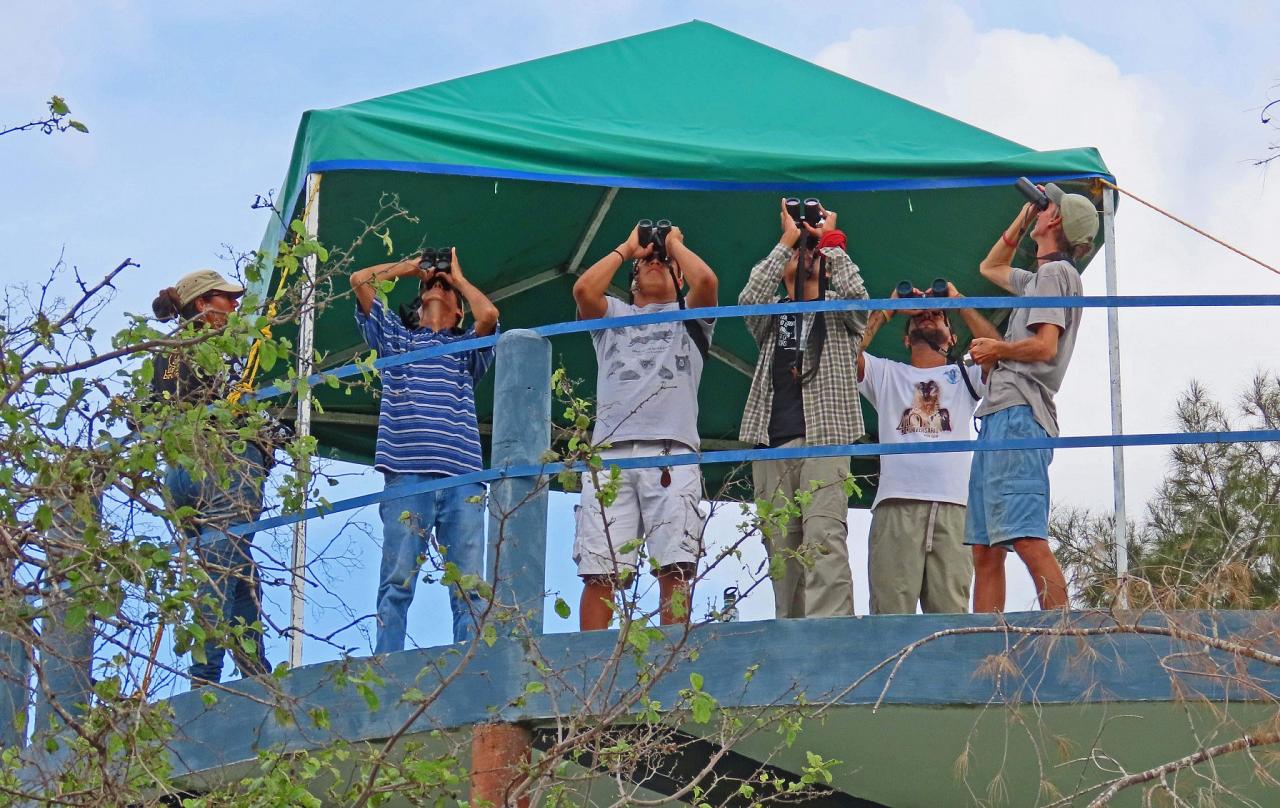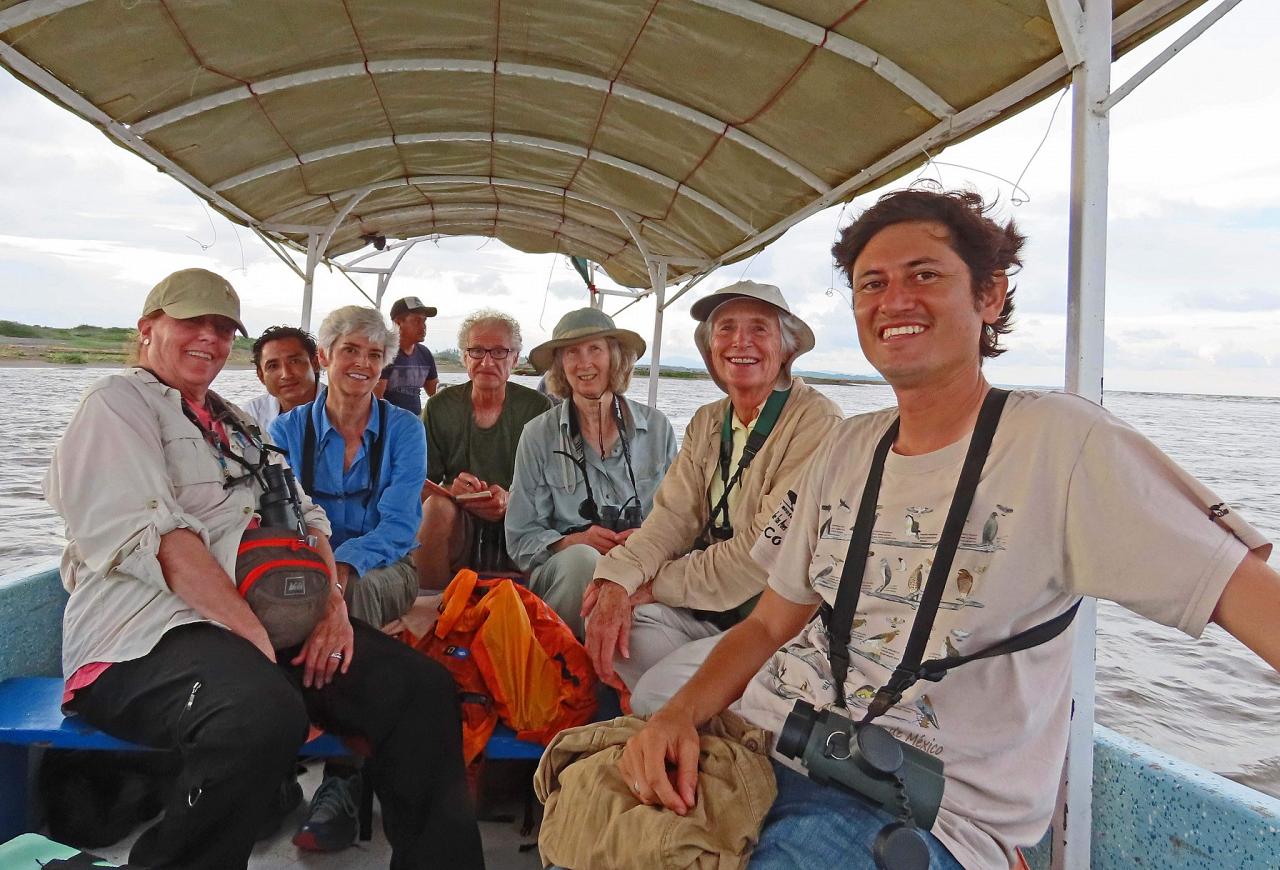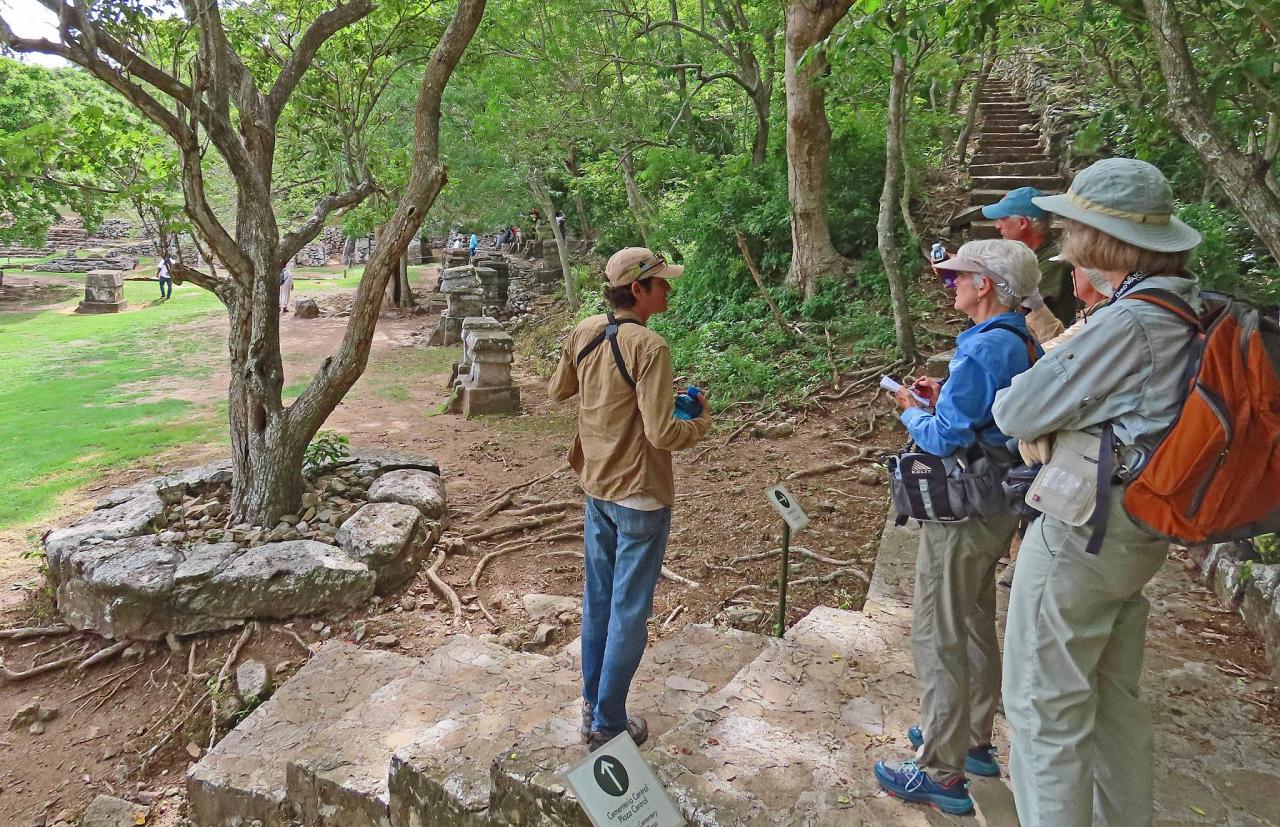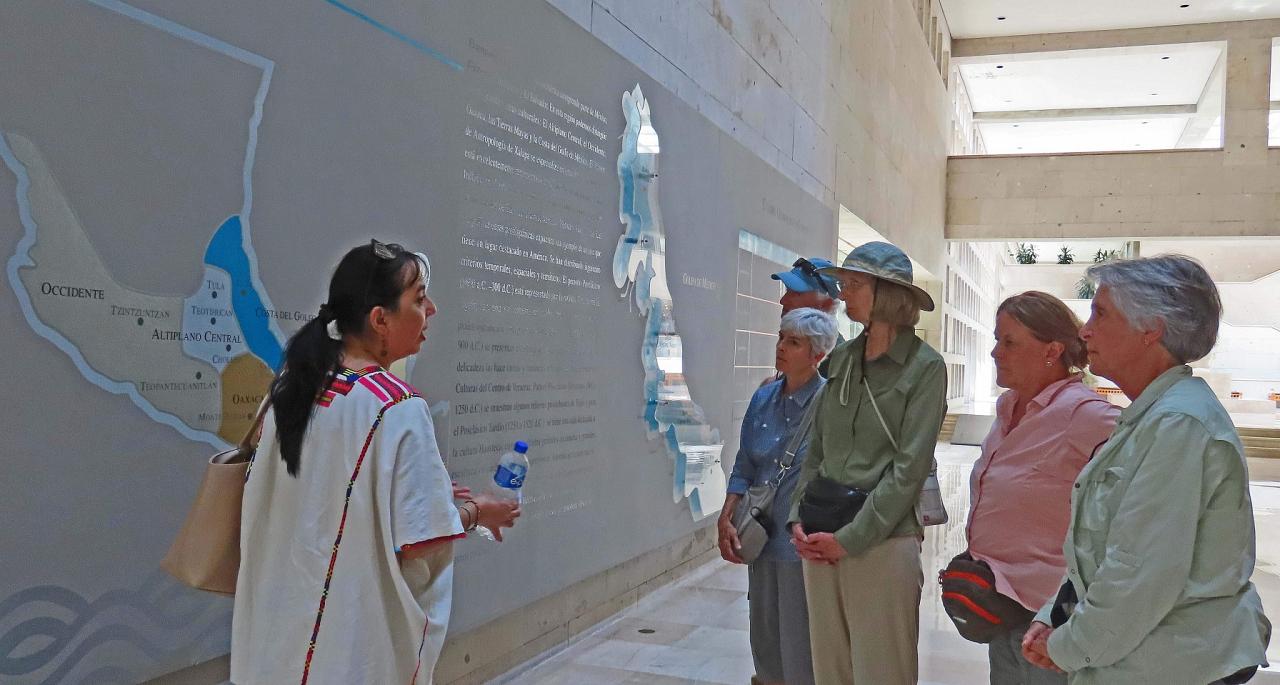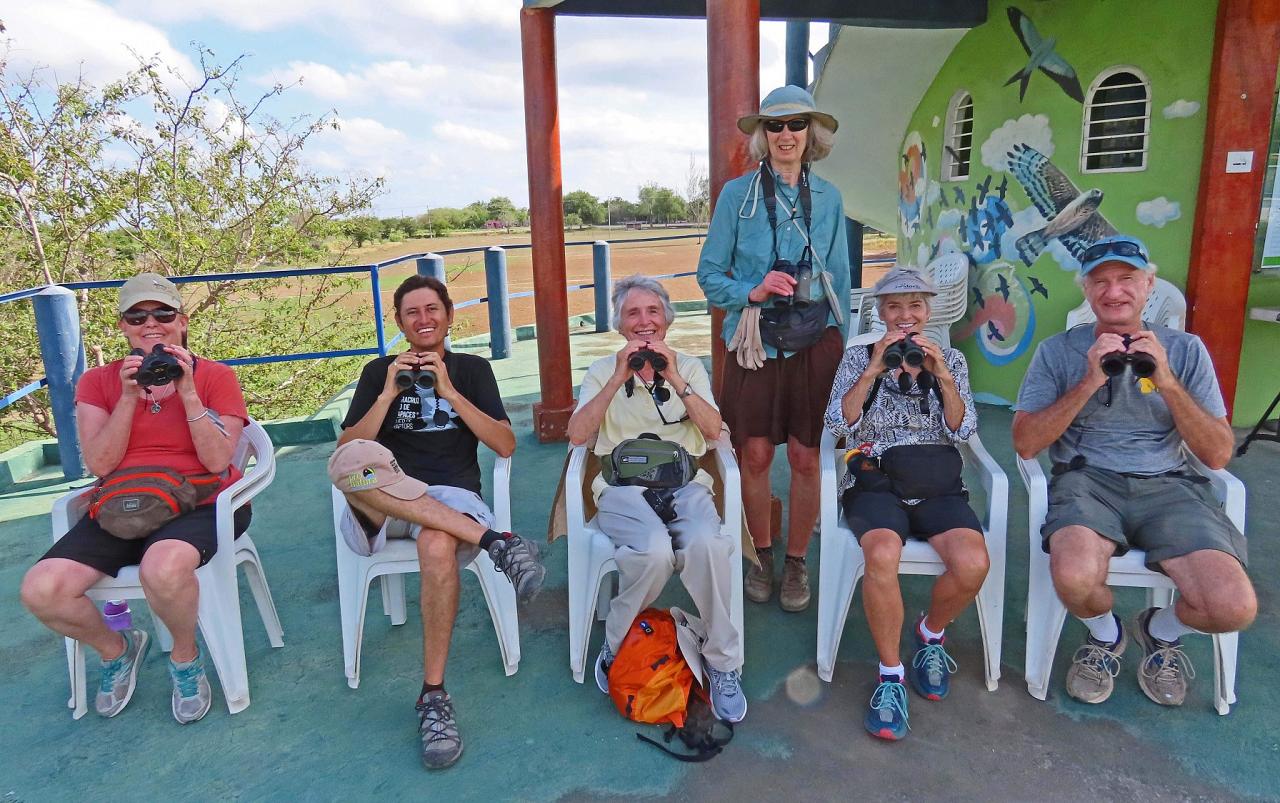Join us on this exciting Mexico birding tour to Veracruz, the migration crossroads of the Americas, the intersection of diverse biological realms, and a site of historical encounters between peoples of the old and new worlds. The State of Veracruz is one of Mexico’s most diverse, with elevations spanning from snow-capped volcanic peaks to sandy beaches on the Gulf of Mexico. On this Mexican birding tour, explore the wide variety of habitats found in the area of Central Veracruz with the chance to discover the world-renowned Veracruz River of Raptors, the largest hawk migration site on the planet. We explore archeological and cultural sites, including the Totonac sites of Cempoala and Quiahuiztlan and the ruins of Hernan Cortez’ first house in the new world. Additionally, we learn about the rewards and challenges of bird and habitat conservation being done by conservation partners in Veracruz.
In addition to seeing raptors on this Mexico migration tour (over 1,000,000 individual hawks and vultures have been counted here daily!), Veracruz is a major migration pathway for passerines, butterflies, and dragonflies. The region is diverse in bird species and is located at the northern edge of many subtropical and tropical species’ range. We also spend time at higher elevation pine-oak and cloud forests to explore the diverse avifauna of Veracruz; visit a shade-coffee plantation to enjoy birds, excellent coffee, and a traditional Mexican lunch. A highlight of the visit is a tour of the renowned Museum of Anthropology in Xalapa, with its extensive collection of pre-colonial Mexican artifacts.
We also travel south on this Mexico nature tour to explore the Los Tuxtlas/Catemaco region, the northernmost extent of true tropical rainforest on the east coast of the Americas. Here we add many more bird species that simply do not occur further north.
Join us for this fun and educational trip to one of the most fascinating parts of Mexico. While we emphasize birding and observing the migration spectacle, we are sure to spend time learning about the ancient and modern cultures of the region, meeting the friendly local people, and enjoying excellent cuisine.
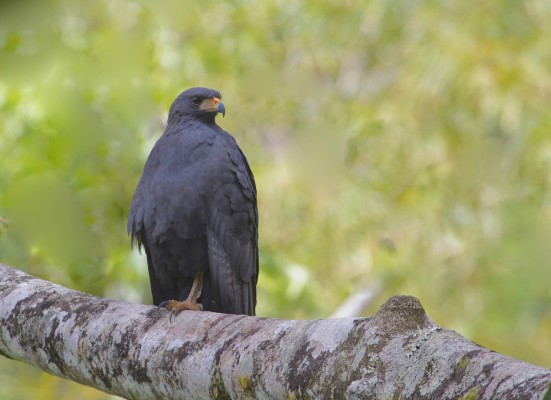
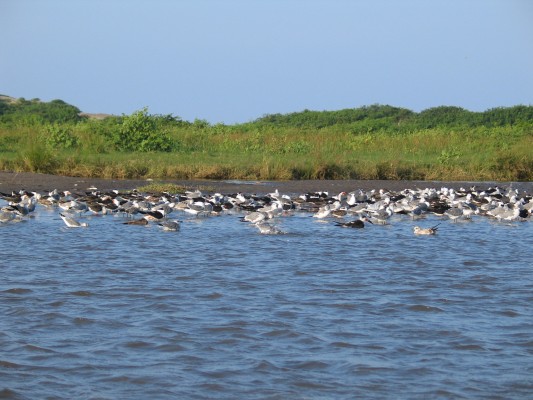
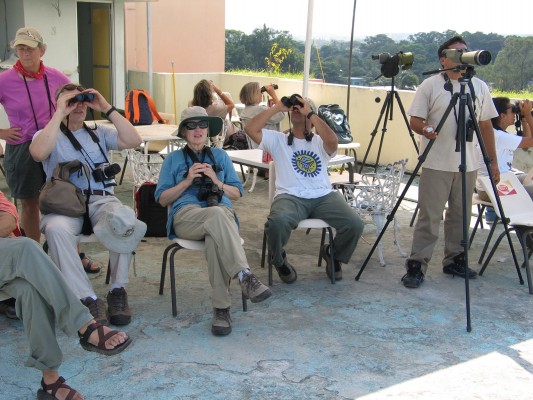
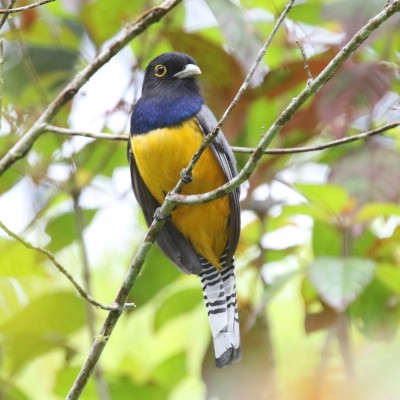
Tour Highlights
- Witness the spectacle of fall migration, with potentially millions of individual raptors, swallows, pelicans, butterflies, dragonflies, and more
- Learn from local conservationists about the exciting habitat protection and restoration work being done in the state of Veracruz
- Explore the ancient Totonac archeological sites of Cempoala and Quiahuixtlan
- Visit the fabulous Museum of Anthropology in Xalapa
- Tour Hernan Cortez's first house in the new world and the old town of La Antigua, site of the oldest church in the Americas
- Bird diverse habitats such as coasts and beaches, rivers, savannah, pine-oak forest, and cloud forest
- Enjoy an evening boat ride down La Antigua River to look for shorebirds, gulls, terns, and herons
- Birdwatch, sample coffee, and eat a classic Mexican lunch at an old coffee hacienda
- Learn about the tropical rainforest and its diverse bird community in the Los Tuxtlas/Catemaco region
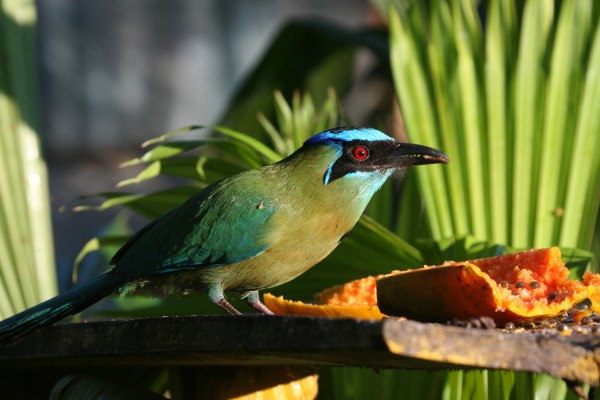
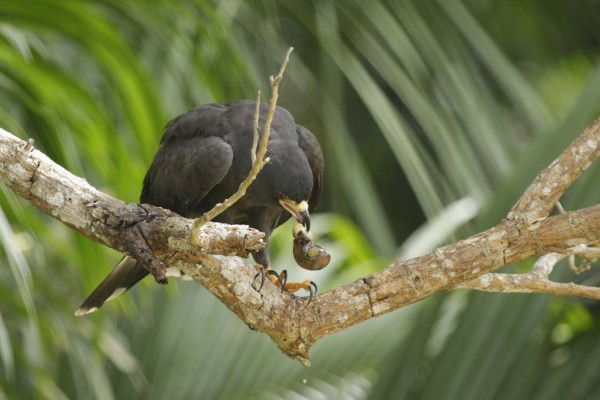
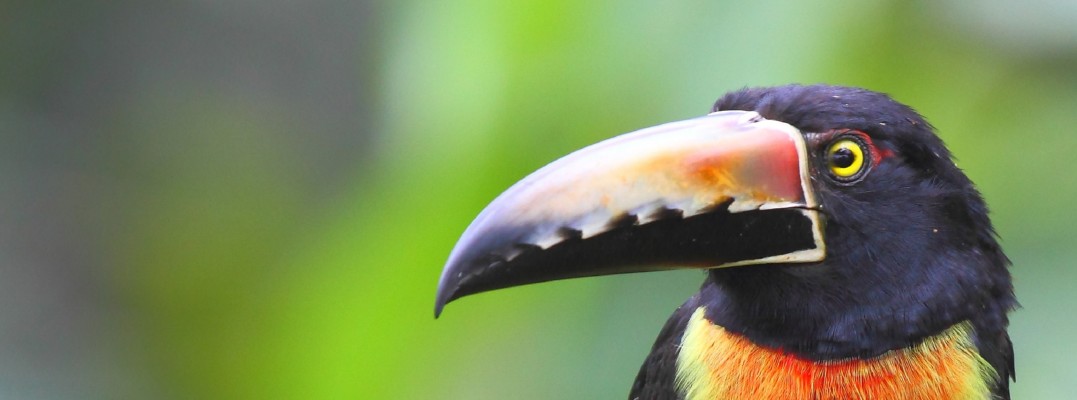
Trip Itinerary
Itineraries are guidelines; variations in itinerary may occur to account for weather, road conditions, closures, etc. and to maximize your experience.
Thurs., Oct. 16: Arrival in Veracruz
Welcome to Mexico! Arrive today at Veracruz International Airport. You can arrive at your leisure; a representative from our local operator transfers you from the airport to our hotel. Dinner tonight is at your leisure, but please feel free to get acquainted with others on the tour through an informal dinner.
Accommodations at Hotel Mocambo, Veracruz
Fri., Oct. 17: Morning Birding | Cempoala Archeological Site
We gather this morning for our first formal group meal. For those interested, we can enjoy an early morning bird walk on the hotel grounds before our sumptuous breakfast. We may find Ferruginous Pygmy-Owl, gulls, terns, seabirds, and songbirds along the beach and in the hotel gardens.
After breakfast, we travel to the town of Cardel, where we visit the archeological site of Cempoala, an important pre-Columbian Totonac site. We’ll receive a tour of the site and its small museum from a local guide to learn about this important coastal Mexican culture. We often see birds at the site, too, including perhaps some migrating raptors. We return to Cardel, our base for the next few days, for lunch. In the afternoon, we concentrate on the raptor migration, either from the roof of our hotel in Cardel or at the alternate hawk-watching site at Chichicaxtle. We hope to see large numbers of Broad-winged Hawk, accompanied by Mississippi Kite, Turkey Vulture, and Swainson’s Hawk. Also present in migration can be numerous Anhinga, American White Pelican, Wood Stork, kingbirds, and swallows.
Dinner tonight is in a local restaurant, followed by an evening program on the Rio de Rapaces project, which includes an introduction to the migrating raptors.
Accommodations at Hotel Bienvenido, Cardel (B,L,D)
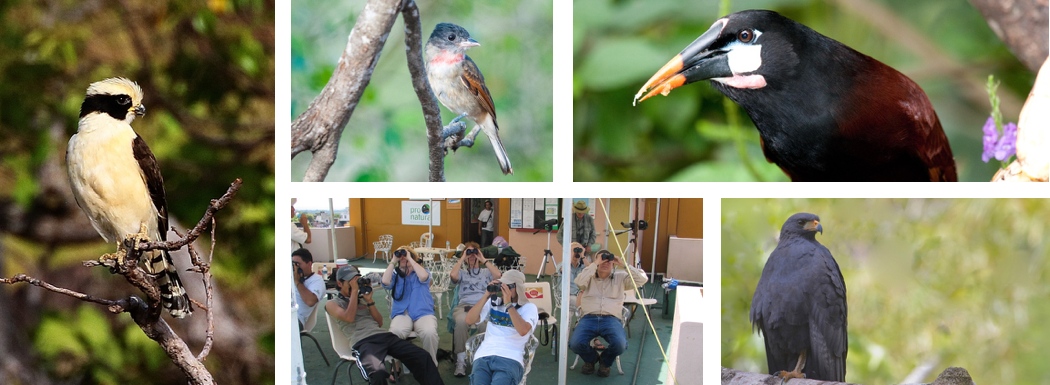
Sat., Oct. 18: Coastal Birding | Afternoon Hawk Watching
We enjoy an early breakfast at the hotel this morning. As with all of our migration tours, the specific agenda for today day may vary, particularly depending on the magnitude of the raptor migration as the day develops. In the morning we visit the Villa Rica area, exploring the wetlands of the area and the mouth of the lagoon. The wetlands may have Bare-throated Tiger-Heron, Black-crowned Night-Heron, Muscovy Duck, Northern Jacana, and Ruddy Crake. The nearby trees along the dunes are often filled with an array of migratory songbirds while hordes of swallows fly overhead. After this great start, we head a bit further north to visit the archeological site of Quiahuiztlan (a beautiful Totonac burial site overlooking the coast).
We return to Cardel for lunch. After lunch, we visit Hernan Cortez’ house in the village of La Antigua; here we also see the first church in the Americas and take a delightful river boat trip on La Antigua River, down and back to its mouth, ending at sunset. Dinner tonight is at an open-air restaurant in La Antigua. Tonight, and at many of our other restaurant stops on the trip, we have the chance to enjoy excellent local seafood from the Gulf of Mexico, deliciously flavored Mexican-style, and quite different from what you may expect from your local Mexican restaurant in the US!
After dinner we go over our list for the day. Birding highlights may include many of the local raptor species such as Grey Hawk, Roadside Hawk, Hook-billed Kite, Great and Common Black Hawk, and Aplomado and Laughing Falcons. Additionally, other local species provide a great introduction to tropical birding with species that include Altamira Oriole, the very local Rufous-naped Wren, Black-headed Trogon, Rose-throated Becard, Black-headed Saltator, all five kingfisher species, Montezuma Oropendola, Aztec Parakeet, and Masked Tityra. At each of the sites, we also hope for a spectacular passerine and water bird migration. The butterfly and dragonfly migration can be spectacular as well.
Accommodations at Hotel Bienvenido, Cardel (B,L,D)
Sun., Oct. 19: Coastal Birding | Afternoon Hawk Watching
After an early breakfast at the hotel, we travel out to the coast to bird Playa Juan Angel (or, Johnny Angel Beach). This gives us a chance to find and see a variety of water- and shorebirds that we are unlikely to encounter elsewhere on the trip. Plus, we hope to encounter a good morning migration of songbirds that pass through along or near the shore. After the morning on the coast, we head inland to look for birds more characteristic of the inland forests and rivers of Veracruz. Species we hope to find include Ferruginous Pygmy-Owl, Squirrel Cuckoo, Gray-crowned Yellowthroat, Rose-throated Becard, Plain Chachalaca, Canyon Wren, and the local, endemic subspecies of Rufous-naped Wren. Plus, the usual swarms of migrating songbirds!
We return to Cardel for lunch and then head out to where the hawk migration is best, either in Cardel or at the Bird Observatory at Chichicaxtle. In addition to the (hopefully) abundant Broad-winged and Swainson’s Hawks and Turkey Vulture, we may see Mississippi Kite, Zone-tailed Hawk, Osprey, Peregrine Falcon, and Snail Kite. The bird observatory also has a small gift shop for us to support the conservation effort directly! At the end of the day, we return to Cardel for dinner and a review of the bird list.
Accommodations at Hotel Bienvenido, Cardel (B,L,D)
Mon., Oct. 20: Shade-Coffee Plantation, Xalapa
After breakfast in Cardel we say goodbye to our accommodations, and we head inland to visit the historic Rancho El Mirador certified shade-coffee hacienda for some delightful birding followed by a traditional Mexican lunch. The birding is fabulous there and, in fact, it is hard to even leave the parking lot! Many forest and second-growth specialties like Blue-capped Motmot, Black-headed Saltator, Collared Aracari, Montezuma Oropendola, Azure-crowned Hummingbird, Ivory-billed Woodcreeper, Tropical Parula, Gartered Trogon, and more are possible. The visit includes a short drive through the coffee plantations, where we also learn from the owner some an insiders perspective on coffee growing and consumption. After birding, we return to the hacienda for a fabulous, home-cooked Mexican lunch with tamales, barbacoa, and more. Those interested have the opportunity to take home some of the genuine shade-grown coffee grown there.
We then head to the higher elevations of Xalapa, the capital city of Veracruz, and its smaller neighbor, Coatepec. We stay for two nights here, just a short ride up the mountains from Cardel. This colonial city is quite lovely, with beautiful architecture, a pleasant climate, and very fine Mexican cuisine, quite different from the coast. Here we visit several sites in the surrounding cloud forest and pine-oak forest, including taking the time to explore around a beautiful waterfall and witness a spectacular 2000-foot canyon. The habitat of the higher elevations here supports many endemic species as well as migrants and other residents, especially of mixed-species flocks. We are joined at dinner tonight by staff of Pronatura Veracruz, a local conservation organization headquartered in nearby Coatepec, to informally discuss the opportunities and challenges of doing conservation in the region.
Accommodations at Posada Coatepec (B,L,D)
Tues., Oct. 21: High Elevation Birding | Xico
Today will be devoted to exploring the higher elevation forests and other habitats above Xalapa, mostly on the slopes of the Cofre de Perote volcano. After an early breakfast, we head up the highway the small community of La Joya (at about 7100 ft). The area around this community is largely dominated by Mexican weeping pine (Pinus patula) with oaks and other hardwoods mixed in. This is a new habitat for outher tour and we hope to see many montane forest species including Brown-backed Solitaire; Golden-browed, Crescent-chested, Hermit, and Townsend’s Warbler; Blue-throated and Amethyst-throated Mountain-Gem; Slate-throated Redstart; Steller’s Jay; Acorn Woodpecker; Yellow-eyed Junco, and Mexican Chickadee. We then continue up in elevation to the area known as Las Minas (about 7750 ft) to look for Red and OIive Warbler, Gray-breasted Wood-Wren, and White-breasted Nuthatch. We will explore the area around the Ejido 20 de Noviembre for Black-headed Siskin and Striped Sparrow.
After lunch at a restaurant, we drive to the historic town of Xico (famous for its mole) and the nearby Cascada (waterfall) de Texolo from the Finca Santa Rosa site where we have our dinner. In addition to a fine view of the falls, we hope to find some interesting birds, including White-naped Brushfinch, Chestnut-headed Oropendola, White-collared Swift, and Violet Sabrewing. We return to Coatepec for dinner and a review of the bird list.
Accommodations at Posada Coatepec (B,L,D)
Wed. Oct. 22: Xalapa | Anthropology Museum
After breakfast, we make a short drive through Xalapa to the Parque Ecológico Macuiltépetl, a
park consisting of an extinct volcanic cone in the middle of the city. We slowly walk and wind our way up to the crater at the top, birding along the way. The birding here can be fabulous, including species such as Blue Mockingbird, Wedge-tailed Sabrewing, White-winged Tanager, Tropical Parula, Fan-tailed Warbler, and Brown-capped Vireo. A small natural history museum near the summit has a
collection of injured and rehabbing hawks, for very close examination.
After lunch at a local restaurant, we head over to the Museo de Antropología de Xalapa (MAX) for a guided tour with a local guide. The MAX is the second-best anthropology museum in Mexico and has a fabulous collection of artifacts and information on Mexican anthropology and archeology, with an emphasis on the cultures that arose along the southeast Mexican coast of the Gulf of Mexico. Breaking away in late afternoon, we proceed back down to Cardel for dinner and the night.
Accommodations at Hotel Bienvenido, Cardel (B,L,D)
Thurs., Oct. 23: Las Barrancas | Alvarado | Tlacotalpan | Catemaco
We pack up early this morning, and after breakfast at the hotel we travel south to spend the morning at Las Barrancas grasslands south of Veracruz City. We keep a special eye peeled for Double-striped Thick-Knee, Yellow-headed Vulture, Snail Kite, Limpkin, American and Pinnated Bittern, Common Tody-Flycatcher, swallows, and other marsh birds. We then proceed to the town of Alvarado, where we load up for our second boat trip around portions of the extensive Alvarado Lagoon wetland complex. The Alvarado Wetlands are a designated Ramsar wetlands of international importance and have been an area of active conservation, restoration, management, and community outreach by Pronatura Veracruz for many years. The boat trip lasts about 2.5 hours, during which we hope to see Common and Great Black Hawk, Russet-naped Wood-Rail, the mangrove race of Yellow Warbler, Mangrove Swallow, Barred Antshrike, Rufous-breasted Spinetail, and Black-collared Hawk.
We stop to have lunch in Tlacotalpan, a World Heritage town along the Papaloapan River. We arrive to Catemaco, our final destination today, in the late-afternoon. We then check into our hotel and enjoy even more local birding and an evening along the shore of beautiful Laguna Catemaco.
Accommodations at Hotel Playa Azul, Catemaco (B,L,D)
Fri., Oct. 24: Nanciyaga | Los Tuxtlas | Balzapote
After breakfast, we begin our exploration of the Catemaco region at the nearby Nanciyaga Reserve, a beautiful forested tract beside the shore of Lake Catemaco. We may hear Howler Monkeys as we enter the reserve. The birding is excellent here; we hope to see Scarlet Macaw, Ivory-billed Woodcreeper, Red-crowned Ant-Tanager, Long-billed and Stripe-throated Hermit, and, with any luck, Great Curassows. We can also observe birds on the lake, possibly including egrets, herons, Neotropical Cormorants, and Ruddy Crake. We then have a delicious lunch at the reserve’s restaurant, featuring hand-made corn tortillas.
After lunch, we head down toward the coast, making a top at the famed Los Tuxtlas Tropical Biological Station. Birding along the road here is also wonderful, possibly including Lesser Greenlet, Yellow-olive Flycatcher, Golden-olive Woodpecker, Ochre-bellied Flycatcher, and Black-crowned Tityras. Migrants can be common, including Red-eyed Vireo, Chestnut-sided Warbler, and American Redstart. If time permits at the end of the afternoon, we may drive all the way down to the coast to admire the view over the gulf—a fine way to conclude the day. We return to our hotel for dinner (with any luck, serenaded by Pauraques) and the bird list review.
Accommodations at Hotel Playa Azul, Catemaco (B,L,D)
Sat., Oct. 25: Ruiz Cortines | Catemaco | Owling
After an early breakfast at our hotel, we head up into the Los Tuxtlas mountains to explore the area near the small community of Ruiz Cortines, the site of a community-based birding tourism effort. This
community is surrounded by high elevation montane and cloud forest, new habitat types for the trip. During the morning, we bird several sites around the town, hoping to find a nice array of species. These may include Ornate Hawk-Eagle, Tuxtla Quail-Dove (endemic to these mountains), Lesson’s Motmot, Eye-ringed Flatbill, Yellow-billed Cacique, Slate-colored Solitaire, Chestnut-capped Brushfinch, Tody Motmot, Buff-throated and Scaly-throated Foliage-Gleaner, Collared Trogon, and Blue-crowned Chlorophonia.
After a long and exciting morning, we return to Ruiz Cortines itself for lunch, in the community operated dining room. Depending on timing, before or after lunch, we will walk to some nearby hummingbird feeders set up by the community in hopes of seeing the Tuxtlas-endemic Long-tailed Sabrewing. In the afternoon, we return to our hotel to relax and do some birding on the grounds. After dinner, we head out just before dark to do some owling in hopes of finding Mottled Owl and other nocturnal species.
Accommodations at Hotel Playa Azul, Catemaco (B,L,D)
Sun., Oct. 26: Catemaco | Veracruz
We have a leisurely breakfast and either do some birding on the hotel grounds, or travel to a nearby spot to find species we have missed. After lunch in Catemaco, we pack and head back to Veracruz, possibly stopping along the way if there is time. We then enjoy our last dinner together in the hotel dining room.
Accommodations at Hotel Mocambo, Veracruz (B,L,D)
Mon., Oct. 27: Departures
You can depart at your leisure this morning.
Cost of the Journey
Cost of the journey is $TBD per person, based on double occupancy, from Veracruz. Cost includes: all accommodations; all meals as stated in the itinerary; group airport transfers; ground transportation within Mexico; professional guide services; park, preserve, and other activity fees; and miscellaneous program expenses. Tour price does not include: roundtrip airfare to and from Veracruz, Mexico, or items of a personal nature such as laundry, porterage, telephone charges, or alcoholic beverages. Gratuities for maids or porters, and other hotel staff, as well as your guides are not included but are appreciated.
Travel Details
Please plan to make air travel plans only after the minimum group size has been met. We will send you a confirmation email as soon as the trip has been confirmed.
Please plan to make air travel plans only after the minimum group size has been reached. Please arrive at Veracruz International (VER) at your leisure on October 16. You can depart at your leisure on October 27.
Browse below for trip reports and species lists from past versions of this and other tours from this destination.
Mexico
Alamos
- November 2017
Butterflies & Birds
- February 2020
- February 2022
- February 2023
- February 2024
Oaxaca
- October 2021
- August 2022
- October 2022
- August 2023
- January 2024
Sea of Cortés
- March 2017
- February 2019
- March 2022
- March 2023
Veracruz
- September 2019
- September 2021
- October 2022
Pace & Protocols +
Photo credits: Banner: Broad-winged Hawk by Peg Abbott; Group at Ruins, Dave Mehlman; Crested Guan, Sandy Sorkin; Group, Brenda Sabo; Golden-olive Woodpecker, Peg Abbott; Common Black Hawk by Greg Smith; Migration by Dave Mehlman; Hawk Watching by Dave Mehlman; Gartered Trogon by Peg Abbott; Blue-crowned Motmot by Peg Abbott; Snail Kite by Peg Abbott; Collared Aracari by James Adams; Migrating White Pelicans, courtesy Pronatura; Archeological Site, Dave Mehlman; Laughing Falcon, Cliff Hensel; Rose-throated Becard, Tom Dove; Montezuma Oropendola, Tom Dove; Raptor Watching, Dave Mehlman; Common Black Hawk, Greg Smith; Blue-crowned Motmot, Peg Abbott; Collared Aracari, James Adams; Olive Warbler, Peg Abbott; Snail Kite, Peg Abbott; Green Jays, Bob Behrstock; Bat Falcon, Hugh Simmons Photography; Pygmy Kingfisher, Peg Abbott; Gallery images courtesy of Dave Mehlman.






